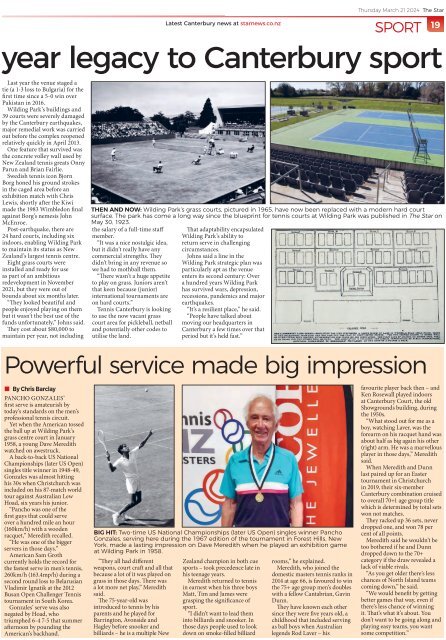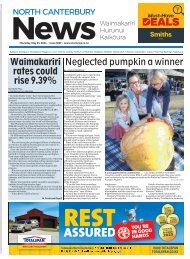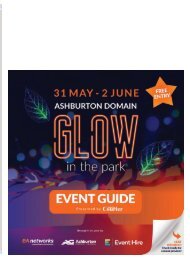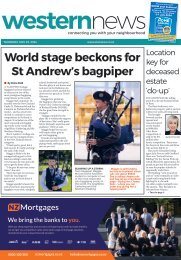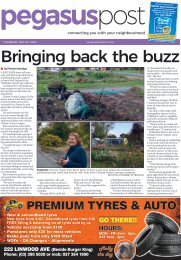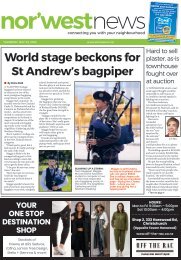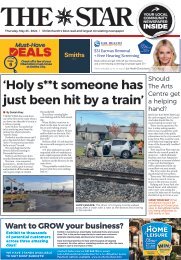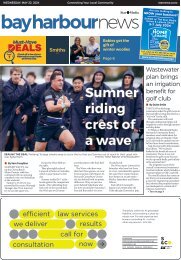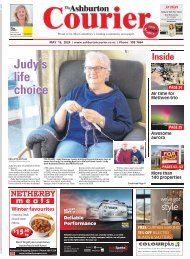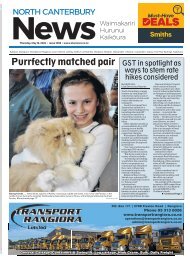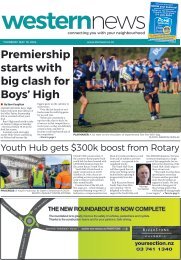The Star: March 21, 2024
Create successful ePaper yourself
Turn your PDF publications into a flip-book with our unique Google optimized e-Paper software.
Thursday <strong>March</strong> <strong>21</strong> <strong>2024</strong> <strong>The</strong> <strong>Star</strong><br />
Latest Canterbury news at starnews.co.nz<br />
SPORT 19<br />
year legacy to Canterbury sport<br />
Last year the venue staged a<br />
tie (a 1-3 loss to Bulgaria) for the<br />
first time since a 5-0 win over<br />
Pakistan in 2016.<br />
Wilding Park’s buildings and<br />
39 courts were severely damaged<br />
by the Canterbury earthquakes,<br />
major remedial work was carried<br />
out before the complex reopened<br />
relatively quickly in April 2013.<br />
One feature that survived was<br />
the concrete volley wall used by<br />
New Zealand tennis greats Onny<br />
Parun and Brian Fairlie.<br />
Swedish tennis icon Bjorn<br />
Borg honed his ground strokes<br />
in the caged area before an<br />
exhibition match with Chris<br />
Lewis, shortly after the Kiwi<br />
made the 1983 Wimbledon final<br />
against Borg’s nemesis John<br />
McEnroe.<br />
Post-earthquake, there are<br />
24 hard courts, including six<br />
indoors, enabling Wilding Park<br />
to maintain its status as New<br />
Zealand’s largest tennis centre.<br />
Eight grass courts were<br />
installed and ready for use<br />
as part of an ambitious<br />
redevelopment in November<br />
20<strong>21</strong>, but they were out of<br />
bounds about six months later.<br />
“<strong>The</strong>y looked beautiful and<br />
people enjoyed playing on them<br />
but it wasn’t the best use of the<br />
funds unfortunately,” Johns said.<br />
<strong>The</strong>y cost about $80,000 to<br />
maintain per year, not including<br />
THEN AND NOW: Wilding Park’s grass courts, pictured in 1965, have now been replaced with a modern hard court<br />
surface. <strong>The</strong> park has come a long way since the blueprint for tennis courts at Wilding Park was published in <strong>The</strong> <strong>Star</strong> on<br />
May 30, 1923.<br />
the salary of a full-time staff<br />
member.<br />
“It was a nice nostalgic idea,<br />
but it didn’t really have any<br />
commercial strengths. <strong>The</strong>y<br />
didn’t bring in any revenue so<br />
we had to mothball them.<br />
“<strong>The</strong>re wasn’t a huge appetite<br />
to play on grass. Juniors aren’t<br />
that keen because (junior)<br />
international tournaments are<br />
on hard courts.”<br />
Tennis Canterbury is looking<br />
to use the now vacant grass<br />
court area for pickleball, netball<br />
and potentially other codes to<br />
utilise the land.<br />
That adaptability encapsulated<br />
Wilding Park’s ability to<br />
return serve in challenging<br />
circumstances.<br />
Johns said a line in the<br />
Wilding Park strategic plan was<br />
particularly apt as the venue<br />
enters its second century: Over<br />
a hundred years Wilding Park<br />
has survived wars, depression,<br />
recessions, pandemics and major<br />
earthquakes.<br />
“It’s a resilient place,” he said.<br />
“People have talked about<br />
moving our headquarters in<br />
Canterbury a few times over that<br />
period but it’s held fast.”<br />
Powerful service made big impression<br />
• By Chris Barclay<br />
PANCHO GONZALES’<br />
first serve is amateurish by<br />
today’s standards on the men’s<br />
professional tennis circuit.<br />
Yet when the American tossed<br />
the ball up at Wilding Park’s<br />
grass centre court in January<br />
1958, a young Dave Meredith<br />
watched on awestruck.<br />
A back-to-back US National<br />
Championships (later US Open)<br />
singles title winner in 1948-49,<br />
Gonzales was almost hitting<br />
his 30s when Christchurch was<br />
included on his 87-match world<br />
tour against Australian Lew<br />
Hoad, six years his junior.<br />
“Pancho was one of the<br />
first guys that could serve<br />
over a hundred mile an hour<br />
(160km/h) with a wooden<br />
racquet,” Meredith recalled.<br />
“He was one of the bigger<br />
servers in those days.”<br />
American Sam Groth<br />
currently holds the record for<br />
the fastest serve in men’s tennis,<br />
260km/h (163.4mp/h) during a<br />
second round loss to Belarusian<br />
Vladimir Ignatik at the 2012<br />
Busan Open Challenger Tennis<br />
tournament in South Korea.<br />
Gonzales’ serve was also<br />
negated by Hoad, who<br />
triumphed 6-4 7-5 that summer<br />
afternoon by pounding the<br />
American’s backhand.<br />
BIG HIT: Two-time US National Championships (later US Open) singles winner Pancho<br />
Gonzales, serving here during the 1967 edition of the tournament in Forest Hills, New<br />
York, made a lasting impression on Dave Meredith when he played an exhibition game<br />
at Wilding Park in 1958.<br />
“<strong>The</strong>y all had different<br />
weapons, court craft and all that<br />
because a lot of it was played on<br />
grass in those days. <strong>The</strong>re was<br />
a lot more net play,” Meredith<br />
said.<br />
<strong>The</strong> 75-year-old was<br />
introduced to tennis by his<br />
parents and he played for<br />
Barrington, Avonside and<br />
Hagley before snooker and<br />
billiards – he is a multiple New<br />
Zealand champion in both cue<br />
sports – took precedence late in<br />
his teenage years.<br />
Meredith returned to tennis<br />
in earnest when his three boys<br />
Matt, Tim and James were<br />
grasping the significance of<br />
sport.<br />
“I didn’t want to lead them<br />
into billiards and snooker. In<br />
those days people used to look<br />
down on smoke-filled billiard<br />
rooms,” he explained.<br />
Meredith, who joined the<br />
domestic masters tennis ranks in<br />
2014 at age 66, is favoured to win<br />
the 75+ age group men’s doubles<br />
with a fellow Cantabrian, Gavin<br />
Dunn.<br />
<strong>The</strong>y have known each other<br />
since they were five years old, a<br />
childhood that included serving<br />
as ball boys when Australian<br />
legends Rod Laver – his<br />
favourite player back then – and<br />
Ken Rosewall played indoors<br />
at Canterbury Court, the old<br />
Showgrounds building, during<br />
the 1950s.<br />
“What stood out for me as a<br />
boy, watching Laver, was the<br />
forearm on his racquet hand was<br />
about half as big again his other<br />
(right) arm. He was a marvellous<br />
player in those days,” Meredith<br />
said.<br />
When Meredith and Dunn<br />
last paired up for an Easter<br />
tournament in Christchurch<br />
in 2019, their six-member<br />
Canterbury combination cruised<br />
to overall 70+1 age group title<br />
which is determined by total sets<br />
won not matches.<br />
<strong>The</strong>y racked up 36 sets, never<br />
dropped one, and won 78 per<br />
cent of all points.<br />
Meredith said he wouldn’t be<br />
too bothered if he and Dunn<br />
dropped down to the 70+<br />
category if the draw revealed a<br />
lack of viable rivals.<br />
“As you get older there’s less<br />
chances of North Island teams<br />
coming down,” he said.<br />
“We would benefit by getting<br />
better games that way, even if<br />
there’s less chance of winning<br />
it. That’s what it’s about. You<br />
don’t want to be going along and<br />
playing easy teams, you want<br />
some competition.”


